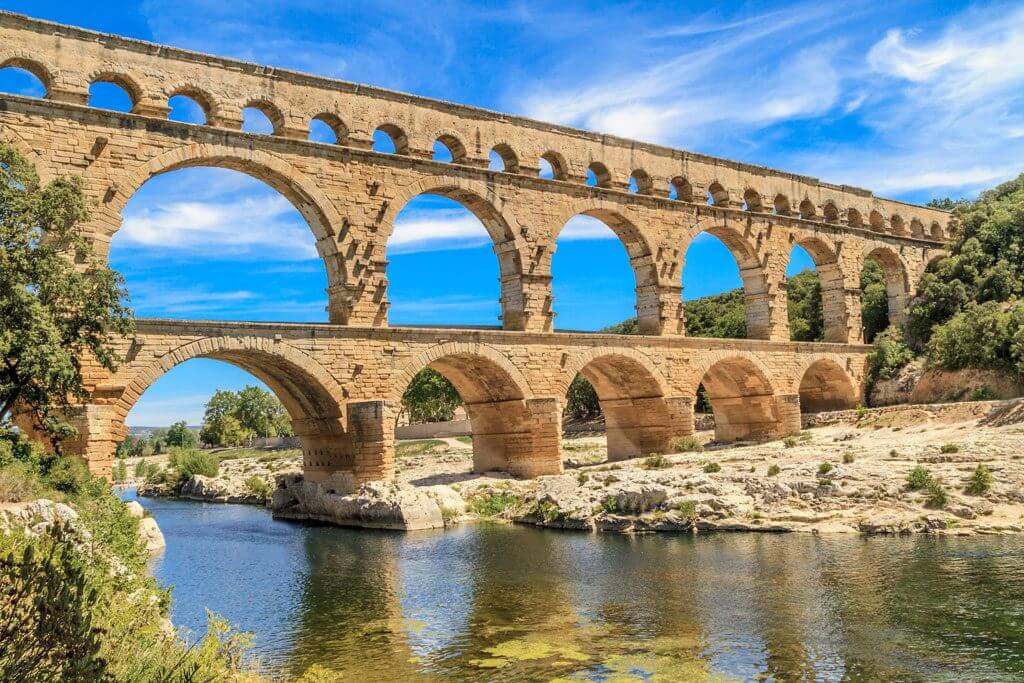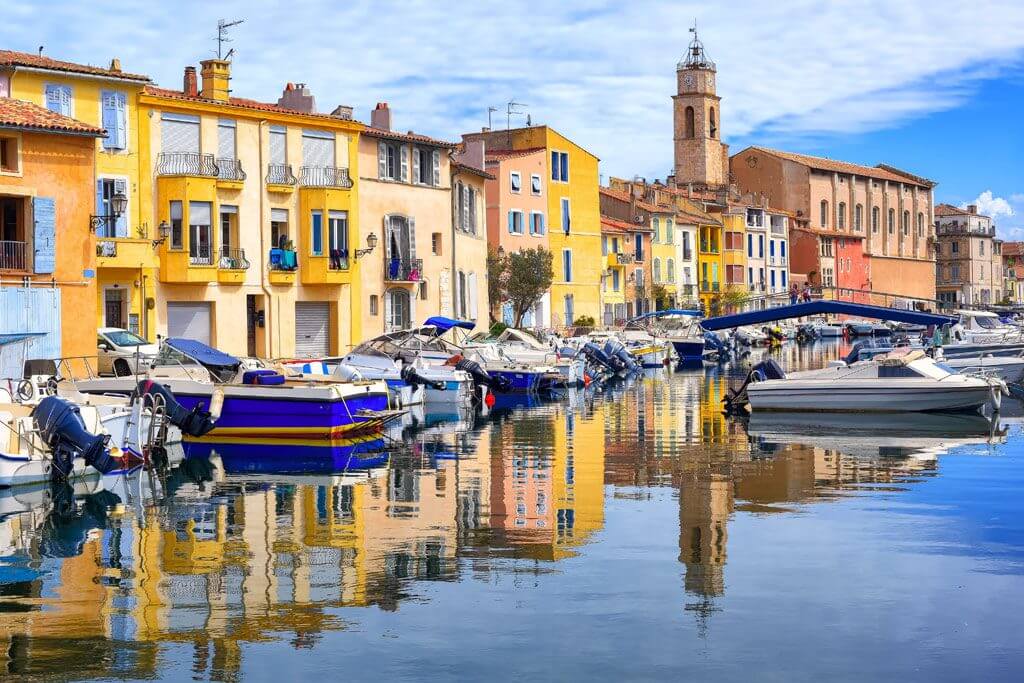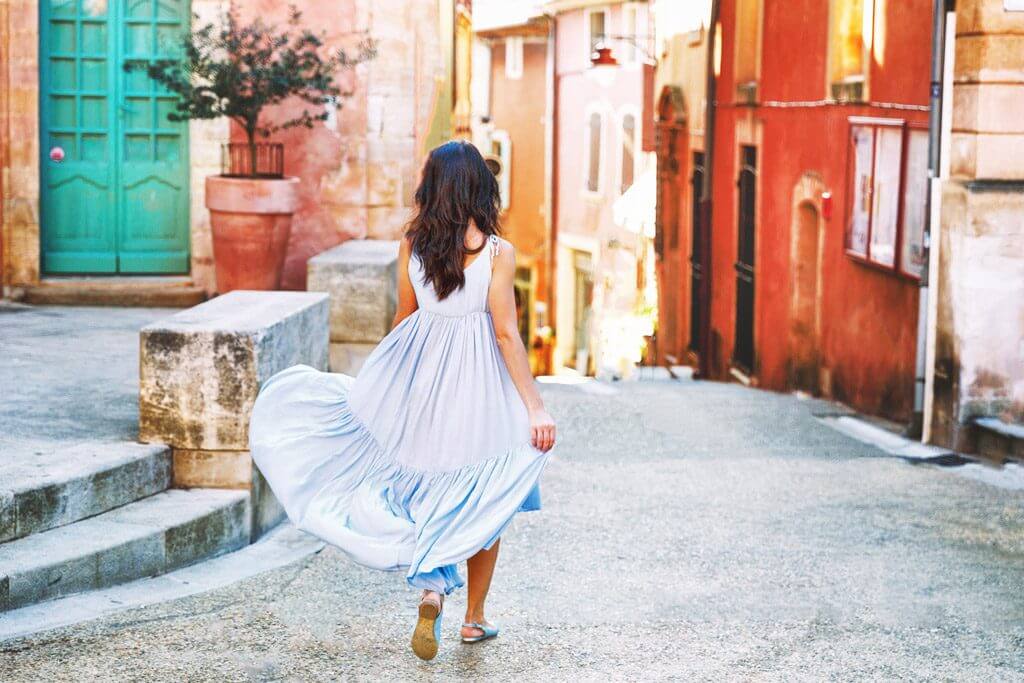Article written by Elisa - Travel Writer & Local in France
This article may contain compensated links. Please read disclaimer for more info.
Occitanie is one of the regions of Southern France. Nestled between the Pyrénées and the Mediterranean Sea, Occitanie is always a trip back to the essential: the land, the sea, and the sky.
A region where sunny days abound, Occitanie is known for its incredible variety of landscapes, a haven for great outdoor experiences. The region also has vibrant cities and some of the cutest small towns in France.
Occitanie is a land with a thrilling history, with Roman sites like the Arena of Nîmes or Pont du Gard. There are also interesting medieval sites like Carcassonne – the gate to the fascinating Cathar Country.

The Occitanie region is another south, far from the French Riviera‘s buzz. It is a land of traditions, where its inhabitants like to take their time and enjoy the small pleasures of this life.
Occitanie France is a relatively new region (2016), and it incorporates the former regions of Languedoc-Roussillon and Midi-Pyrénées. The main city in Occitanie is Toulouse.
Occitanie is divided into thirteen departments: Ariège, Aude, Aveyron, Gard, Haute-Garonne, Gers, Hérault, Lot, Lozère, Hautes-Pyrénées, Pyrénnées-Orientales, Tarn, and Tarn-et-Garonne.
Occitanie is diverse, and that’s good! Go on reading for the list of the best things to do in Occitanie, France, and the top places to visit in Occitanie to get a glimpse of its history, culture, and natural wonders.
Related posts
Occitanie Travel
BY AIR: the airport Toulouse-Blagnac (TLS) is one of the main international airports in France, with many international connections to Europe and the Maghreb. Other smaller airports have many connections to the UK, especially Montpellier-Méditerranée (MPL), Carcassonne-Salvaza (CCF), and Tarbes-Lourdes-Pyrénées (LDE).
Book your flight tickets to Toulouse
BY TRAIN: Train travel in France is straightforward. Three high-speed train lines (LGV) cross the region, serving cities like Toulouse, Montpellier, Nîmes, and Perpignan. The rest of the region is connected to these cities through regional trains (TER).
Explore Occitanie by Car
For extended trips in the region of Occitanie, the best way to get around is by car. This region is an excellent place for memorable French road trips. With a car, some good tunes, and the best company, you are set for one of the best adventures in your life. Driving in France is very easy, and with the car, you can go off the beaten path to visit the best of Normandy.
Recommended road trips in Occitanie:
If you don’t have a car, we recommend booking in advance through platforms like Discover Cars. This site takes all of the major rental companies, such as Hertz, Avis, etc., and compares prices for you. Check out our best tips for renting a car in France.
Best Places to Visit in Occitanie France
Let’s have a look at the best places to visit in Occitanie, France. The list of things to do in Occitanie and Occitanie tourist attractions includes vibrant cities, sea towns, natural wonders, and historical monuments.
1. Toulouse, the Pink City

Located on the banks of the Garonne River, Toulouse is the capital of the Occitanie region. Toulouse is a pleasant city where life is good. Also, it is Europe’s aeronautical capital, with the largest space center in Europe.
In the city, center distances are never far, and it is possible to go everywhere on foot. Visitors exploring Toulouse will discover admirable churches, charming narrow streets, sumptuous buildings, remarkable architecture, and a rich cultural heritage.
Feeling blue? Head to Toulouse! The Pink City owes its nickname to its brick architecture, with all shades of pink – depending on the time and the place – ocher and red that give the cityscape a look that it’s impossible to compare with any other city.
Start your wanderings at Place du Capitole; the city seems to gravitate always towards this place. Then explore Old Toulouse with its little squares and private mansions, riveting museums exploring the cosmos, prehistory, ancient art, and the natural world. Finally, take a more than deserved break in one of the city’s beautiful parks – Click here to book your stay in Toulouse
2. Pont du Gard

The Pont du Gard aqueduct is a Roman construction built during the first century AD to channel water from the Eure River’s source in Uzés all the way to Nîmes. Along the way, the Gardon River was a difficult obstacle, and it was overcome by the construction of the Pont du Gard.
Pont du Gard was used as an aqueduct until the 6th century. Then it became a tollgate in the Middle Ages and later a road bridge from the 18th to the 20th centuries.
A UNESCO World Heritage site, Pont du Gard is a true technical feat. It measures 48 meters high, and it has three vertical rows of arches: 6 on the lowest level, 11 on the second level, and 35 on the third and top level. Don’t miss the Museum of the Pont du Gard, which retraces the history of the aqueduct’s construction.
The Pont du Gard makes a great day trip from Nîmes, Uzés, or Avignon. You can also reach the foot of Pont du Gard by kayak, sailing the Gardon River. Some of the tours proposed are available all year.
3. Carcassonne & The Cathar Country

The Cathar Country (Pays Cathare in French) is one of the most fascinating areas to visit in Southern France, with an incredible heritage and a turbulent history of heresy and crusades. The Cathar Country is an ensemble of medieval castles, villages, and Romanesque abbeys related to the Cathars and Catharism – a Christian dualist movement that thrived in southern Europe –, especially in the Languedoc Region between the 12th and the 14th centuries. These sites were witnesses of the conflict between the Catholic Church and the Cathars 800 years ago.
The Cité de Carcassonne is one of the most important sites in the Cathar Country and one of the top Occitanie destinations. The city became a land of heresy in Pope Innocent III’s eyes, and it was one of the main targets during the first Cathar Crusade in 1209, led by Simon de Montfort.
TIP: this Carcassonne 2-hour Walking Tour gets always very good reviews
The Cathar Country is best explored by car as most of these sites are poorly served (or not served at all) by public transportation. Here’s our suggested itinerary for a road trip in the Cathar Country, combining history, culture, and stunning scenery.
4. The Villages of Aveyron

Located in the heart of the Occitanie region, the Aveyron is full of history and exceptional sites. With an altitude ranging from 144 to 1,463 meters, the Aveyron goes from the desert plateau of Larzac to green valleys crisscrossed by rivers.
The Aveyron is a land of character – rough and sweet at the same time – where life tends to slow down, just like in the old times. The Aveyron is also a paradise for food and nature lovers.
More than anything, the Aveyron is a place of picturesque medieval villages, with more official Most Beautiful Villages in France than in any other region.
Where to start? There are Conques, located along the Santiago de Compostela pilgrimage route, and other lovely villages like Belcastel, Najac, or Peyre.
5. Sant Martí del Canigó & Sant Miquel de Cuixà Abbeys

The Canigó (Canigou in French) is a mountain in the Pyrénées that has symbolic significance for the Catalan people. For the Catalans, the Canigó is a sacred place of legends and mysteries, but also a national symbol that inspired poets like Jacint Verdaguer, author of the poem Canigó. The English journalist and writer Rudyard Kipling visited Vernet-les-Bains many times between 1910 and 1926, and declared himself ‘among the loyal subjects of the Canigou.’
Unfortunately, this area of the Pyrénées passed into French hands after the Treaty of the Pyrénées in 1659, when King Philip IV of Castille and Aragon ceded the lands of Northern Catalonia, with its capital in Perpignan, to the French King Louis XIV. This was a setback for Catalonia, as it lost 1/5 of its territory. Most importantly, the second city in the country (Perpignan) was left in foreign hands.
On the mountains of Massif del Canigó, we find Sant Martí del Canigó (today Saint-Martin du Canigou) and Sant Miquel de Cuixà (Saint-Michel de Cuxa), two beautiful Benedictine abbeys founded in the 10th century by the Count Guifré II of Cerdanya. Both sanctuaries are jewels of Catalan Romanesque architecture in the Pyrenées and listed historical monuments.
Sant Martí del Canigó has a spectacular setting, perched in the mountains. Not far, Sant Miquel de Cuixà is well-known for its beautiful Romanesque cloister, with impressive capitals decorated with monsters and other strange creatures. It is possible to visit the two abbeys on a day trip from Perpignan or Barcelona. We recommend!
6. Parc National des Cévennes

Created in 1970, the Cévennes National Park is one of the ten national parks in France and one of the two parks to be inhabited, also in its core zone. The UNESCO has distinguished this vast territory as a Biosphere Reserve for the particular balance between man and nature.
The richness of the park is based on the variety of natural environments and landscapes: from the granitic highlands of Mont Lozère to the majestic forests of Aigoual, or the vast limestone plateaus of the Causse Méjean carved out from the spectacular Gorges du Tarn and de la Jonte, Cévennes is this and much more.
There are many ways to explore the magnificent landscapes of Cévennes National Park: on foot (5,000 kilometers of signposted trails and paths), on horseback, by mountain bike, or by practicing sports like canoeing kayaking, climbing, via Ferrata, and more.
7. Albi, la Rouge

Located in the Tarn department, the city of Albi is nicknamed ‘La Rouge’ (the red) because of its architecture made of red brick. This bastion of Catholic power was the base for the bloody 13th-century Albigensian Crusade against the Cathars, and it still looks like it’s ready for war.
Albi does not make part of the Cathar Route, but if you are interested in Catharism, it makes sense to extend your explorations to Albi. The Cathars were known as Albigensians because of their association with the city of Albi and because the 1176 Church Council, which declared the Cathar doctrine heretical, was held near Albi.
Albi is one of our favorite places to visit in Occitanie. Here, you cannot miss the Cité Episcopale, listed as UNESCO World Heritage since 2010. The Cité Episcopale is a well-preserved and unique representation of urban development of this kind in Europe. Developed around the cathedral and the palace-fortress, the Cité Episcopale dates back to the 13th century! It covers 20 hectares and regroups four medieval neighborhoods, historical monuments, major sites, and the Tarn river banks.
Albi is a great destination for a cultural weekend and an excellent base for exploring other beautiful corners of the Tarn department – Click here to book your stay in Albi
8. The Arènes of Nimes

Nimes was founded in the 1st century with the name of Nemausus by the veterans of the Gallic Legion. Often referred to as the French Rome, Nimes boasts a beautiful heritage from Roman times, with monuments like the Tour Magne, the Maison Carrée, and the Arènes de Nimes.
Les Arènes de Nîmes is a Roman amphitheater built around 70 CE in the city. It is not the most extensive Roman amphitheater in the world, but it is the best preserved. Built to host different kinds of shows to entertain the locals, it measures 133 meters long and 101 meters wide, and it has two floors and an attic separated by a cornice.
Les Arènes de Nîmes is one of the top tourist attractions in Occitanie. It organizes shows for tourists and locals, and it is also possible to visit every day except when there’s a show.
9. Béziers

The medieval city of Béziers was an important stronghold of Catharism. During the Cathar Crusade, Béziers was the first place to be attacked.
The Catholics of Béziers were given an ultimatum to hand over the heretics or leave before the Crusaders besieged the city. Finally, they decided to refuse, and they resisted with the Cathars.
With the words ‘Kill them all, God will recognize his own’ by a legate of the Pope of Rome, the Crusaders gave free rein to the ‘grande boucherie’ (big butchery) in Béziers: the city burnt and all its population, Cathars and Catholics, died.
Today people come to Béziers to visit its impressive Saint-Nazaire Cathedral, built in the 13th century atop a steep rock. The city’s Romanesque bridge over the Orb River (12th century) is also a wonder. This bridge was the single river crossing point from Provence to Toulouse for many centuries. Béziers is also a great place to explore Canal du Midi by boat or bike.
10. Gorges du Tarn

Gorges du Tarn is one of the best Occitanie destinations for nature lovers. It consists on a huge canyon sculpted in the limestone plateau by the Tarn River, between the Causse Méjean and the Causse de Sauveterre. Gorges du Tarn is home to picturesque villages, medieval churches, and old châteaux and fortresses.
Today, this area is well known for its various outdoor activities like rafting, rock climbing, or kayaking. It is also a beautiful area to explore on a road trip, with great sites and incredible views.
11. The Camargue

The Camargue is one of the most unique places to visit in Occitanie and all of France. This natural area between the regions of Occitanie and Provence-Alpes-Côte d´Azur, with an extension of more than 100,000 hectares, is world-known for its magnificent open spaces and exceptional fauna: flamingos, breeding bulls, horses.
Whether you visit the Camargue on a weekend getaway or a longer vacation, be sure to book your stay well in advance. The best places to set your base camp to visit the Camargue are Arles, Les-Saintes-Maries-de-la-Mer, Aigues-Mortes, and Saint-Gilles. For a unique stay, however, book at Hotel La Tramontane, located in a beautiful environment near Saintes-Maries-de-la-Mer, and with a beautiful infinity pool and good on-site restaurant – Click here to book your stay in the Camargue
12. Canal du Midi

Stretching from Toulouse to Sète, the Canal du Midi is one of the most popular Occitanie tourist attractions for bike lovers, but not only.
The Canal du Midi is a feat of architectural genius that connects the Atlantic Ocean to the Mediterranean Sea. This 17th-century construction designed by Pierre-Paul Riquet required 12,000 men over fifteen years, from 1666 to 1681.
Here, visitors can hire boats, hotel-barges, or rent bikes and make their way along the canal at their own pace. Some hikers use the trail along the canal to make their way toward the Camino de Santiago in Spain.
13. Mediterranean Towns

Bordered by the Mediterranean Sea, the Occitanie region has no shortage of pretty coastal towns perfect for some days of bathing, relaxation, and water sports.
Here, you can find some of the most glorious beaches in France, vibrant fishing villages, and thriving market towns.
Amongst the coastal towns that populate the coast in Occitanie outstands Collioure – the center of the Fauvism movement; Gruissan – characterized by its typical beach houses built on stilts; or Sète – raised from nothing to connect the Canal du Midi to the Mediterranean Sea.
Occitanie Food & Wine

Occitanie offers excellent regional specialties, quite different depending on where you are.
In the former region of Languedoc-Roussillon, visitors will find good seafood platters of clams, oysters, and mussels, the famous cassoulet (bean stew casserole with pork or duck) from Castelnaudary, the excellent rice from the Camargue, and many kinds of biscuits and pastries.
The Languedoc–Roussillon wine region is one of France’s largest wine-producing areas by vineyard surface area, even if it is not as famous as other wine regions in France.
Languedoc wines are excellent and affordable and include Merlot, Cabernet, and Syrah. Also, there are plenty of quality whites, such as Sauvignon Blanc, Chardonnay, Grenache, and Muscat Blanc.
The list of typical dishes of the Pyrénées includes Tarbes beans, lamb, aligot (a creamed potato dish with cheese), and garbure (a mountain soup with cabbage and chunks of ham). The Pyrénées are also famous for their cheeses, both cow’s milk and sheep’s cheeses, paired with wines from local domains such as Jurançon, Gaillac, Cahors, Madiran, and Armagnac.
We hope that you enjoyed this list of the best things to do in Occitanie, France. If you want to learn about other regions in France, head to this article on the French Regions, where we have summarized each region’s highlights.



